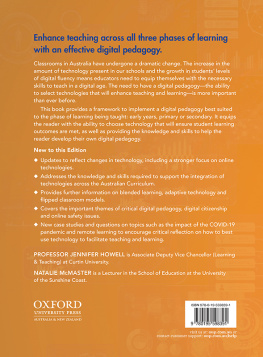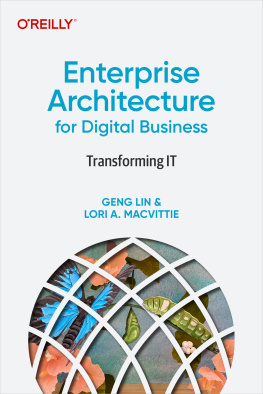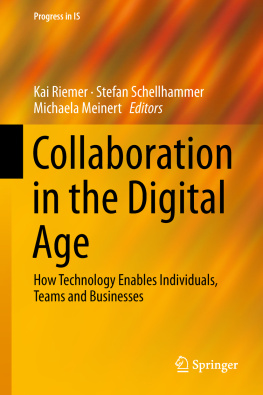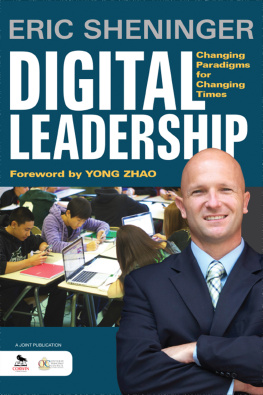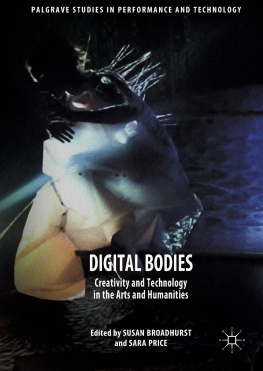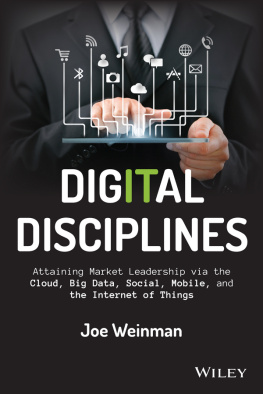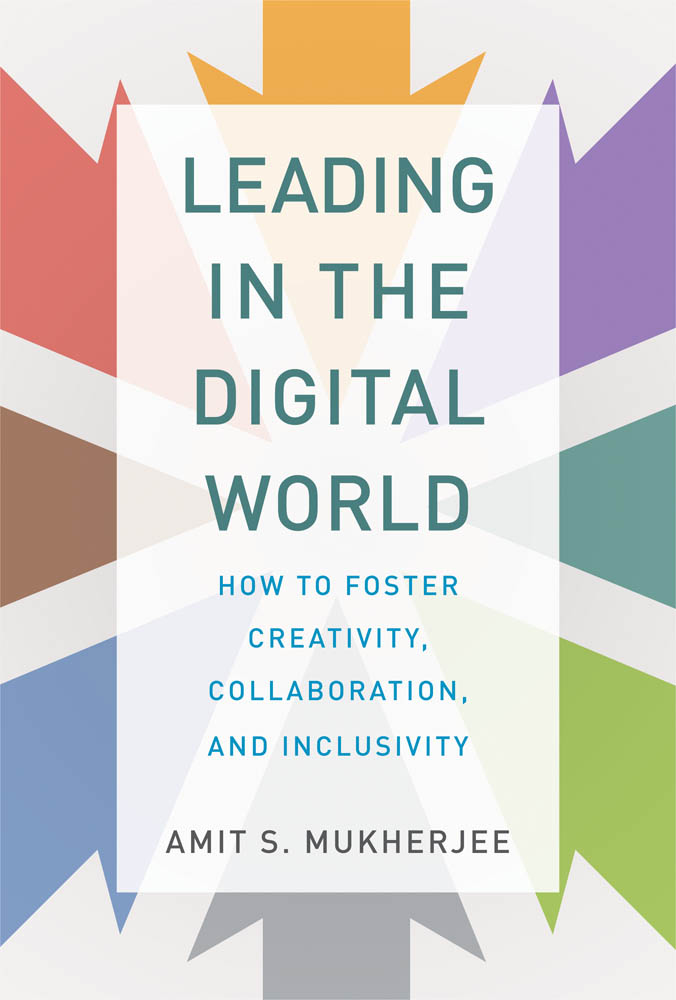Contents
Guide
Pagebreaks of the print version
Management on the Cutting Edge Series from MIT Sloan Management Review
Edited by Paul Michelman
Published in cooperation with MIT Sloan Management Review
The AI Advantage: How to Put the Artificial Intelligence Revolution to Work
Thomas H. Davenport
The Technology Fallacy: How People Are the Real Key to Digital Transformation
Gerald C. Kane, Anh Nguyen Phillips, Jonathan Copulsky, and Garth Andrus
Designed for Digital: How to Architect Your Business for Sustained Success
Jeanne W. Ross, Cynthia M. Beath, and Martin Mocker
See Sooner, Act Faster: How Vigilant Leaders Thrive in an Era of Digital Turbulence
George S. Day and Paul J. H. Schoemaker
Leading in the Digital World: How to Foster Creativity, Collaboration, and Inclusivity
Amit S. Mukherjee
Leading in theDigital World
How to Foster Creativity,Collaboration, and Inclusivity
Amit S. Mukherjee
The MIT Press
Cambridge, Massachusetts
London, England
2020 Massachusetts Institute of Technology
All rights reserved. No part of this book may be reproduced in any form by any electronic or mechanical means (including photocopying, recording, or information storage and retrieval) without permission in writing from the publisher.
Library of Congress Cataloging-in-Publication Data
Names: Mukherjee, A. S. (Amit Shankar), author.
Title: Leading in the digital world : how to foster creativity, collaboration, and inclusivity / Amit S. Mukherjee.
Description: Cambridge, Massachusetts : The MIT Press, [2019] | Series: Management on the cutting edge | Includes bibliographical references and index.
Identifiers: LCCN 2019031915 | ISBN 9780262043946 (hardcover)
Subjects: LCSH: Technological innovations. | Creative ability. | Leadership.
Classification: LCC HD45 .M845 2019 | DDC 658.4/092--dc23 LC record available at https://lccn.loc.gov/2019031915
For Eric Mukherjee
Scholar-in-Training
and
Vijay Ghei
Extraordinary Creator
Contents
List of Figures
- Globally, when work is distributed, executives dont lead well across national differences and organizational boundaries.
- Worldwide, executives arent leading effectively across national differences and organizational boundaries (for regions with n > 50).
- Compared to ten years ago, the business environment has become more VUCA.
- The collaboration gap: Executives fall short of expectation worldwide (for regions with n > 50).
- The thinking gap: In general, thought content of work has risen, but executives themselves dont have to think more (for regions with n > 50).
- The creativity gap: Though there is a need to foster creativity and promote learning, executives dont think their own leaders do so well (for regions with n > 50).
- Executives worldwide arent taking peoples needs into account while implementing digital technology projects.
- Years of experience needed for cross-border or cross-organizational responsibilities (data are for 600 survey respondents).
- Network analysis of three groups in a company.
- Network analysis of three geographies in a company.
- The double diamond phases.
- The seven types of errors.
List of Table
- How the Producing Leader differs from the other models for leading creativity
Series Foreword
The world does not lack for management ideas. Thousands of researchers, practitioners, and other experts produce tens of thousands of articles, books, papers, posts, and podcasts each year. But only a scant few promise to truly move the needle on practice, and fewer still dare to reach into the future of what management will become. It is this rare breed of ideameaningful to practice, grounded in evidence, and built for the futurethat we seek to present in this series.
Paul Michelman
Editor in chief
MIT Sloan Management Review
Preface: What Can Yet Another Book on Leadership Possibly Say That Is Different?
Amazon.com recently offered over 50,000 results when I searched for business leadership books. So, you may justifiably ask, What makes this book different? Dont buy, borrow, or read this book if my response doesnt (at least) intrigue you.
Leadership Books Typically Adopt One of Two Fallacious Perspectives
The first fallacious perspective is Emulate this great man (usually a man) who behaved in this manner/acted thus/had these characteristics. The man is usually a very extroverted and very rich American or British of Caucasian ethnicity. These characteristics collectively exclude most people worldwideincluding most Americans, Brits, Canadians, Australians, and New Zealanders. Yet, they bias our views: Even recently, Ive heard superstar leadership professors at top schools extol the virtues of a square jaw and advise women to lower the pitch of their voices. Even if you personally conform to this flawed stereotype, you cant afford to believe it. Quite often in the digital world, the people wholl crucially influence (your) success wont conform to it.
The second fallacious perspective is Our research (with tons of data) shows that these competencies are key for leadership. These competency models unavoidably assume that competencies that were useful in the past continue to be so. Moreover, they often embody unfounded cultural assumptions. For example, one suggests that dutiful people are less likely to protect subordinates from superiors. This devalues the performance of billions of people from cultures where not being dutiful is explicitly dishonorable. No wonder that many Pacific Asian business executives want Asian models of leadership. But thats a flawed solution: Instead of substituting one cultural paradigm for another, business leadership standards in the digital world must embrace diverse peoples equally.
Moreover, Leadership Models Typically Ignore the Oversized Role of Technology
Leadership experts present their percepts as ageless and universal, rarely mentioning technology. Digital technology experts see leadership merely as a tool necessary for guiding complex projects. Both groups ignore the changes digital technologies are demanding of leaders.
A brilliant academic study of centuries of coevolution of technologies and business identified epochal transitions that produced tumultuous change. Each time, sets of novel technologieslike todays digital technologiesraised corporate performance by orders of magnitude. They had long arcs of impactdecades, even centuries, later, we still use them. Not surprisingly, embracers often thrived; those that didnt inevitably faltered.
Embracing these technology sets wasnt easy: The long-arc-of-impact technologies demanded very difficult transformations of work, values, and organizational structure that changed companies and even transformed societies.
Leading in the Digital World differs from all other leadership books because it provides a model of leadership that reflects the impact of digital technologies. Instead of jumping onto the bandwagon of disruptiona grossly overused term that has gotten disconnected from its originally intended meaningit describes precisely how digital technologies are upending the nature of work and organizational structures and, hence, the context for leadership.


